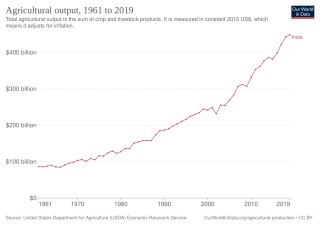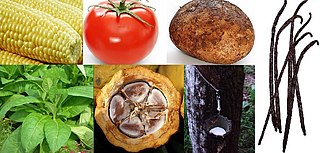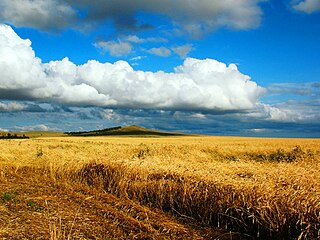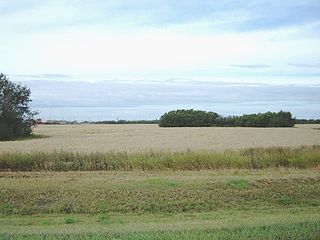Related Research Articles

An agricultural subsidy is a government incentive paid to agribusinesses, agricultural organizations and farms to supplement their income, manage the supply of agricultural commodities, and influence the cost and supply of such commodities.
Dumping, in economics, is a form of predatory pricing, especially in the context of international trade. It occurs when manufacturers export a product to another country at a price below the normal price with an injuring effect. The objective of dumping is to increase market share in a foreign market by driving out competition and thereby create a monopoly situation where the exporter will be able to unilaterally dictate price and quality of the product. Trade treaties might include mechanisms to alleviate problems related to dumping, such as countervailing duty penalties and anti-dumping statutes.

Organic certification is a certification process for producers of organic food and other organic agricultural products, in the European Union more commonly known as ecological or biological products. In general, any business directly involved in food production can be certified, including seed suppliers, farmers, food processors, retailers and restaurants. A lesser known counterpart is certification for organic textiles that includes certification of textile products made from organically grown fibres.

Floriculture is the study of the efficient production of the plants that produce showy, colorful flowers and foliage for human enjoyment and the human environment. It is a commercially successful branch of horticulture and agriculture found throughout the world. Efficient production practices have been developed over the years, for the hundreds of plant taxa used in the floral industry, increasing the overall knowledge of whole plant biology. Plant breeding and selection have produced tens of thousands of new genotypes for human use. Jasmine, Marigold,Chrysanthemum, Rose, Orchid, Anthurium etc. are flowers of commercial demand.

A smallholding or smallholder is a small farm operating under a small-scale agriculture model. Definitions vary widely for what constitutes a smallholder or small-scale farm, including factors such as size, food production technique or technology, involvement of family in labor and economic impact. Smallholdings are usually farms supporting a single family with a mixture of cash crops and subsistence farming. As a country becomes more affluent, smallholdings may not be self-sufficient, but may be valued for the rural lifestyle. As the sustainable food and local food movements grow in affluent countries, some of these smallholdings are gaining increased economic viability. There are an estimated 500 million smallholder farms in developing countries of the world alone, supporting almost two billion people.

Canada is one of the largest agricultural producers and exporters in the world. As with other developed nations, the proportion of the population agriculture employed and agricultural GDP as a percentage of the national GDP fell dramatically over the 20th century, but it remains an important element of the Canadian economy. A wide range of agriculture is practised in Canada, from sprawling wheat fields of the prairies to summer produce of the Okanagan valley. In the federal government, overview of Canadian agriculture is the responsibility of the Department of Agriculture and Agri-Food.

The history of agriculture in India dates back to the Neolithic period. India ranks second worldwide in farm outputs. As per the Indian economic survey 2020 -21, agriculture employed more than 50% of the Indian workforce and contributed 20.2% to the country's GDP.

A crop is a plant that can be grown and harvested extensively for profit or subsistence. In other words, crop is a plant or plant product that is grown for a specific purpose such as food, fibre or fuel.

Agriculture in Kazakhstan remains a small scale sector of Kazakhstan's economy. Agriculture's contribution to the GDP is under 10% – it was recorded as 6.7%, and as occupying only 20% of labor. At the same time, more than 70% of its land is occupied in crops and animal husbandry. Compared to North America, a relatively small percentage of land is used for crops, with the percentage being higher in the north of the country. 70% of the agricultural land is permanent pastureland.

The floral industry is focused on the production, distribution and sale of flowers for human enjoyment. The floral industry began in the Golden Century of the Netherlands, where flowers were grown on a large scale on vast estates. The industry continues to diversify from the production of cut flowers to the production and sale of plants and flowers in many different forms. The global floral industry market size is estimated to be worth US$ 50040 million in 2022 and is forecast to increase to US$ 58030 million by 2028 with a compound annual growth rate of 2.5% during the review period.

Agriculture in Saskatchewan is the production of various food, feed, or fiber commodities to fulfill domestic and international human and animal sustenance needs. The newest agricultural economy to be developed in renewable biofuel production or agricultural biomass which is marketed as ethanol or biodiesel. Plant cultivation and livestock production have abandoned subsistence agricultural practices in favor of intensive technological farming resulting in cash crops which contribute to the economy of Saskatchewan. The particular commodity produced is dependent upon its particular biogeography or ecozone of Geography of Saskatchewan. Agricultural techniques and activities have evolved over the years. The first nation nomadic hunter-gatherer lifestyle and the early immigrant ox and plow farmer proving up on his quarter section of land in no way resemble the present farmer operating huge amounts of land or livestock with their attendant technological mechanization. Challenges to the future of Saskatchewan agriculture include developing sustainable water management strategies for a cyclical drought prone climate in south western Saskatchewan, updating dryland farming techniques, stabilizing organic definitions or protocols and the decision to grow, or not to grow genetically modified foods. Domestically and internationally, some commodities have faced increased scrutiny from disease and the ensuing marketing issues.

Agriculture in Colombia refers to all agricultural activities, essential to food, feed, and fiber production, including all techniques for raising and processing livestock within the Republic of Colombia. Plant cultivation and livestock production have continuously abandoned subsistence agricultural practices in favour of technological farming resulting in cash crops which contribute to the economy of Colombia. The Colombian agricultural production has significant gaps in domestic and/or international human and animal sustenance needs.

Agriculture is one of the main industries in Taiwan. It contributes to the food security, rural development and conservation of Taiwan. Around 24% of Taiwan's land is used for farming.

Agriculture in Israel is a highly developed industry. Israel is a major exporter of fresh produce and a world-leader in agricultural technologies despite the fact that the geography of the country is not naturally conducive to agriculture. More than half of the land area is desert, and the climate and lack of water resources do not favor farming. Only 20% of the land area is naturally arable. In 2008, agriculture represented 2.5% of total GDP and 3.6% of exports. While farmworkers made up only 3.7% of the work force, Israel produced 95% of its own food requirements, supplementing this with imports of grain, oilseeds, meat, coffee, cocoa and sugar.

Organic farming is practiced around the globe, but the markets for sale are strongest in North America and Europe, while the greatest dedicated area is accounted for by Australia, the greatest number of producers are in India, and the Falkland Islands record the highest share of agricultural land dedicated to organic production.

Agriculture in Kenya dominates Kenya's economy. 15–17 percent of Kenya's total land area has sufficient fertility and rainfall to be farmed, and 7–8 percent can be classified as first-class land. In 2006, almost 75 percent of working Kenyans made their living by farming, compared with 80 percent in 1980. About one-half of Kenya's total agricultural output is non-marketed subsistence production.

Agriculture in Portugal is based on small to medium-sized family-owned dispersed units; however, the sector also includes larger-scale intensive farming export-oriented agrobusinesses backed by companies. The extent of cooperative organisation has been reaching a greater importance with globalization. Portugal produces a wide variety of products, including green vegetables, rice, corn, wheat, barley, olives, oilseeds, nuts, cherries, bilberry, table grapes and edible mushrooms. Forestry has also played an important economic role among the rural communities and industry. In 2013, the gross agricultural product accounted for 2.4% of the GDP. Portugal is the largest world producer of both cork and carob, as well as the third largest exporter of chestnut and the third largest European producer of pulp. Portugal is among the top ten largest olive oil producers in the world and is the fourth biggest exporter. The country is also one of the world's largest exporters of wine, being reputed for its fine wines. The land area of slightly more than 9.2 million hectares was classified as follows : 2,755 arable land and permanent crops, 530 permanent pasture, 3,640 forest and woodland, and 2,270 other land.

Cut flowers are flowers and flower buds that have been cut from the plant bearing it. It is removed from the plant for decorative use. Cut greens are leaves with or without stems added to the cut flowers for contrast and design purposes. These displays improve the quality of the human environment.

Coffee production in Tanzania is a significant aspect of its economy as it is Tanzania's largest export crop. Tanzanian coffee production averages between 30,000 and 40,000 metric tons annually of which approximately 70% is Arabica and 30% is Robusta.

Floriculture is a significant industry in Taiwan. Taiwan is one of the largest flower exporters in the world and the top producer of orchids.
References
- 1 2 "Kenya Flower Industry: Kenya Flower Council (KFC)". The Embassy of the Republic of Kenya in Japan. Retrieved 2016-10-27.
- ↑ "Mrs. Jane Ngig—Chief Executive Officer, KFC Secretariat" . Retrieved 2016-10-27.
- ↑ "Kenya Flower Council—Flowers And Plants Growing, Trade and Agriculture Association". Kenya Flower Council. Retrieved 2016-10-27.
- 1 2 3 4 "Industry Statistics". Kenya Flower Council. Retrieved 2016-10-27.
- ↑ Major players in the industry includes but not limited to Finlay Flowers Ltd, Flamingo HorOculture Kenya Ltd, Kariki Group, Mzurri Farms, P. J. Dave Farms, Sian Agriflora Farms, and Vegpro Group. "KFC Members List and Flowers Grown as of August 2016" (PDF). The Embassy of the Republic of Kenya in Japan. Retrieved 2016-10-27.
- ↑ Wilson, Matthew (2015-02-28). "Why flowers in UK vases are causing tensions in Kenya". Financial Times. Retrieved 2016-10-27.
- 1 2 Veselinovic, Milena (2015-03-06). "Got roses this Valentine's Day? They probably came from Kenya". CNN. Retrieved 2016-10-27.
- ↑ Moulds, Josephine (2015-01-16). "EU trade agreements threaten to crush Kenya's blooming flower trade". the Guardian. Supply Chain. Retrieved 2016-10-27.
- 1 2 "Kenya's flower standards to be in place by end of 2015". NAIROBI, (Xinhua): Flowerweb. Retrieved 2016-10-27.
- ↑ "Horticultural Crops Development Authority (HCDA)". Agricultural Information Resource Centre (AIRC). Retrieved 2016-10-27.
- ↑ "The Kenya Flower Industry". The Embassy of the Republic of Kenya in Japan. Retrieved 2016-10-27.